Introduction:
In the world of software development and web applications, APIs play a vital role in enabling communication between different software components. However, with great power comes great responsibility, as APIs can also introduce security vulnerabilities if not handled properly. In this blog post, we will explore the API10:2023 vulnerability and provide practical examples of testing, performing, and exploiting this vulnerability using popular tools like Postman and Burp Suite. 
Understanding API10:2023 Vulnerability:
API10:2023, or “Unsafe Consumption of APIs,” refers to the risks associated with consuming APIs in an insecure manner. This vulnerability can lead to a range of security issues, including unauthorized access, injection attacks, data leakage, and more. It is crucial for developers and security professionals to be aware of this vulnerability and take appropriate measures to prevent exploitation.
Testing API10:2023 Vulnerabilities:
To test for API10:2023 vulnerabilities, follow these steps: Step 1: Identify the API endpoints: Start by identifying the API endpoints that you want to test. Look for areas where data is consumed or passed between the client and server. Step 2: Test for input validation: One of the common causes of API vulnerabilities is insufficient input validation. Check if the API adequately validates and sanitizes user input, such as query parameters, headers, and request bodies. Test for common injection attacks like SQL injection, XSS, and OS command injection. Step 3: Verify authentication and authorization mechanisms: Ensure that the API has proper authentication and authorization mechanisms in place. Test for vulnerabilities like insufficient or weak authentication, broken session management, and privilege escalation. Step 4: Assess error handling: APIs should handle errors gracefully without revealing sensitive information. Check if error messages disclose too much information that can be exploited by attackers.
Performing and Exploiting API10:2023 Vulnerabilities:
Now, let’s explore a practical example of how to perform and exploit API10:2023 vulnerabilities using Postman and Burp Suite. Example Scenario: Consider an API endpoint that retrieves user profile information based on an ID. We will simulate an API10:2023 vulnerability by bypassing authentication and accessing sensitive user data. Step 1: Intercept the request: Launch Burp Suite and configure your browser to route traffic through Burp. Intercept the request to the user profile API endpoint using Burp’s proxy feature. Step 2: Modify the request: Using Burp Suite’s intercept feature, modify the request parameters to bypass authentication. For example, you can remove or modify the authentication header or session cookie to gain unauthorized access. Step 3: Forward the modified request: Once the request is modified, forward it to the server and observe the response. If the vulnerability exists, you should receive the user profile data without proper authentication. Step 4: Mitigation: To fix this vulnerability, ensure that the API enforces proper authentication and authorization checks before providing access to sensitive data. Implement secure session management, access control mechanisms, and validate all user inputs.
Conclusion:
API10:2023 vulnerability, or “Unsafe Consumption of APIs,” poses significant risks to the security of web applications. By understanding and testing for these vulnerabilities, developers and security professionals can take proactive steps to protect their APIs and prevent potential exploitation. Tools like Postman and Burp Suite provide valuable assistance in identifying and mitigating these vulnerabilities. Remember to regularly update your APIs, follow secure coding practices, and prioritize security throughout the software development lifecycle to ensure robust protection against API10:2023 vulnerabilities.
Citations:
https://owasp.org/API-Security/editions/2023/en/0xaa-unsafe-consumption-of-apis/ https://salt.security/blog/api10-2023-unsafe-consumption-of-apis
For further clarifications or support, please write to contact@paradigmitcyber.com

